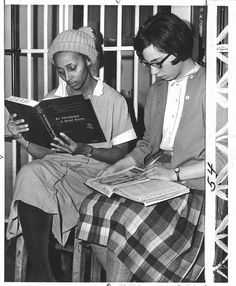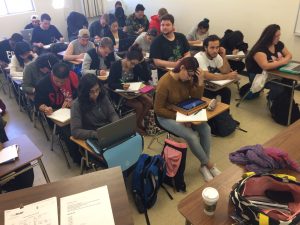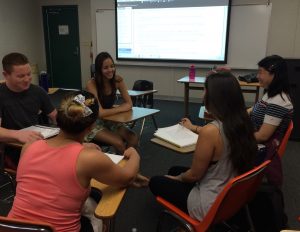“The more that you read, the more things you will know. The more that you learn, the more places you’ll go.” ― Dr. Seuss
To Dr. Seuss I offer this rejoinder: in the digital age (think eBooks and audiobooks), the more places we go, the more we can read. The more we can read, the more we know. The more we travel, the more we learn. The more we learn, the more grow!
Seriously though, every time I board an airplane and witness the sea of readers perusing paperbacks, kindles, newspapers, and magazines, my heart brims with joy. Clearly, travel—even if it’s just for the purpose of commuting—is conducive to learning. After all, what better way to fill those spaces in-between than with thought exploration?
On the note of reading in the online realm, I would like to humbly bring forth two excellent resources I use: Project Gutenberg and Librivox.
Project Gutenberg
Warnock advises we use books students can easily procure or access; at MiraCosta I do not consider this an issue, but I agree distance learners may have more trouble acquiring needed texts. Still, while half of my confused mind responded with “well what about Amazon? Ebay? Half.com?”—those places deliver everywhere, it seems!—the other half tuned in to what he said about publishers and quality e-learning materials (Warnock 60).
Project Gutenberg is in their own words, “the first provider of free electronic books, or eBooks,” and the name suggests an homage to Johannes Gutenberg of the original printing press. What Project Gutenberg contains more specifically is a fantastic database of over 56,000 free eBooks, most or all with an expired copyright. Very exciting is this tidbit: ” On January 1, 2019, items published in 1923 will enter the public domain in the US.”
Anyway, there are a lot of wonderful books anyone can access or download for free. My students enjoy browsing the site, and I certainly frequented it many times as a student myself. I’m still a proponent of the traditional paperback, but our online students might really appreciate Gutenberg’s accessibility.
Here’s the link to Project Gutenberg.
Librivox
As someone who spends a lot of time driving, I’m always looking for interesting podcasts, music, and audiobooks to listen to. Librivox in this sense is a commuter’s oasis: It is an organization that offers free public domain audiobooks. And let me say, there are lot of offerings! Have you ever wanted to listen to all the Sherlock Holmes tales? Or perhaps you’d rather brush up on the classics? No matter your taste in literature, I can promise Librivox has something for you! (/endcommercial) The best part is they have a spiffy app which makes listening on-the-go a breeze. Alternately, you can download their audiobooks onto your computer and transfer them to a flash drive or smartphone that way.
I love Librivox. Students who find reading a challenge can read along with the speaker or use Librivox as an auditory comprehension aid. One last thing I wanted to mention on Librivox’s behalf is the books are all read by volunteers; for popular texts, there are often several different recordings. This means that if you don’t fancy one reader’s voice, sometimes there are other uploads read by different volunteers.
Here’s the link to Librivox.

Chapter 7 Notes and Responses
Warnock advises bundling readings and materials together. I think this is only natural, and paired with keeping some units hidden, is something I do for all my CMS pages. One of the trickiest parts of an online class is minimizing student confusion. But, bundling units and modules together and limiting which ones are visible can control and neutralize a lot of that chaos.
I am constantly trying to think of new ways to include the seven major learning styles. To that end, multimodal materials are great ways of bringing the readings to life. I often try to build units that include a dynamic array of “texts”: including not just articles but short-readings, videos, documentaries, prezis, art, comics, film clips, and/or recordings to offer a diversity of texts encourages student interest in class lessons (Warnock 63). Students who find one type of media dry will often meet one of the others with a bit more excitement and attendance. (Warnock also suggests checking out our school library. MiraCosta’s library has so. many. resources! I schedule an orientation for all my classes at the beginning of each semester in hopes my students take advantage of our vast subscriptions.)
As far as how we make sure our students do the readings, I hate to admit it, but quizzes are effective. I’ve tried out several scenarios for my f2f courses: last semester, I didn’t assign reading quizzes, but rather asked my students to journal and write informal responses (65). Discussion fell flat, and participation was low. So now I assign reading quizzes, and the result is lots of great discussion and surprisingly high participation. However, as with low-stakes writing, I do like my quizzes to be low-stakes as well. I set mine up the same way Warnock does: in short, they are easy-A obvious quizzes that take very little time to complete. They are basically rewards for students who do the reading, and “doh! I should have read!” moments for students who don’t. They are very easy, and I usually like to add in a silly “don’t mark this one!” answers occasionally to negate some of the possible test-taking anxiety. (Btw, here’s a good study on humor and test-taking). I still have my students journal—I love journaling—but the quizzes ensure students actually read.
Chapter 8 Notes and Responses
The most “of course” chapter of them all! If we teach online, effective communication is absolutely vital. Warnock gives us quite an overview.
Message Boards: Discussion boards are critical ways students share their thoughts, but also present methods for us to assign (not so) secret process work. In both formal and informal responses, they explore their ideas. By sharing feedback and responding to one another—and establishing clear parameters defining how they should be replying—students become renewable unending fountains of knowledge by which they enhance their critical thinking and broaden their world views! Conceivably, at least, with some degree of optimism and encouragement. 🙂
I agree that being involved means not just as the professor giving directions, but also as a participant who asks the students questions and moderates the responses. Warnock gives a lovely overview on the plethora of response-types we use and the hats we wear. But, as the professor giving directions, being as detailed as possible and providing a model (77) is much appreciated by students. As a kinesthetic learner myself, there is very real value in learning through emulation. (Exploratory learning is equally important!) As previously mentioned, asking my students not just to post primary responses but to respond to each other as well—I usually ask them to do this a minimum of twice—encourages in-depth conversation which in turn can work well towards unpacking the assigned readings (81).
Grading: As far as grading posts go, I like to use a check, check minus, and check plus system: If the student’s post met all the requirements but was not overly-elaborate or outstanding, it receives a check. This is good! Checks, plain and simple, are good! They are equivalent to a score of 90/100. If the post needed some work or was missing requirements, it receives a check minus. This is not bad! Check minuses are basically, I use the same scale, the same as 80/100. Finally, if the post went above and beyond, it is given a check plus—the laurel leaves of online response. If there was no post at all, then the work is marked as a zero. These checks are eventually graded cumulatively for an overall Discussions Grade.
Accessibility: As far as this goes, I am still a fan of offering a multitude of ways students can reach me. I think this process becomes challenging in the online realm but is still very workable. Using e-mail is the norm, but also having assigned “virtual office hours” is a nice way to be present synchronously. My idea would be to be available on chat at certain hours—that would give students the chance every week to ask questions real time. I like fireside chats, so perhaps I could have two types of virtual office hours: formal (for Q&A sessions) and informal. However, if students would rather talk with me individually, I’d set up a private chat session instead. Zoom and Skype are also, of course, promising ways of establishing f2f sessions for my online students. The possibilities really are endless.




 Honestly, I got bored and frustrated with the traditional charting that I learned in the CAPI and RIAP Summer Institutes. I had to make it work for my class, teaching, most importantly, my students. I started Student Led Class Discussions which is a form of charting done in small groups and are presented to the class (the group leads the discussion of their section of the reading). So for example, for reading Mark Slouka’s “Quitting the Paint Factory,” students were assigned groups and each group was assigned 3-6 paragraphs. Then they had to do the following first individually as homework, and then together in class with their group:
Honestly, I got bored and frustrated with the traditional charting that I learned in the CAPI and RIAP Summer Institutes. I had to make it work for my class, teaching, most importantly, my students. I started Student Led Class Discussions which is a form of charting done in small groups and are presented to the class (the group leads the discussion of their section of the reading). So for example, for reading Mark Slouka’s “Quitting the Paint Factory,” students were assigned groups and each group was assigned 3-6 paragraphs. Then they had to do the following first individually as homework, and then together in class with their group:



